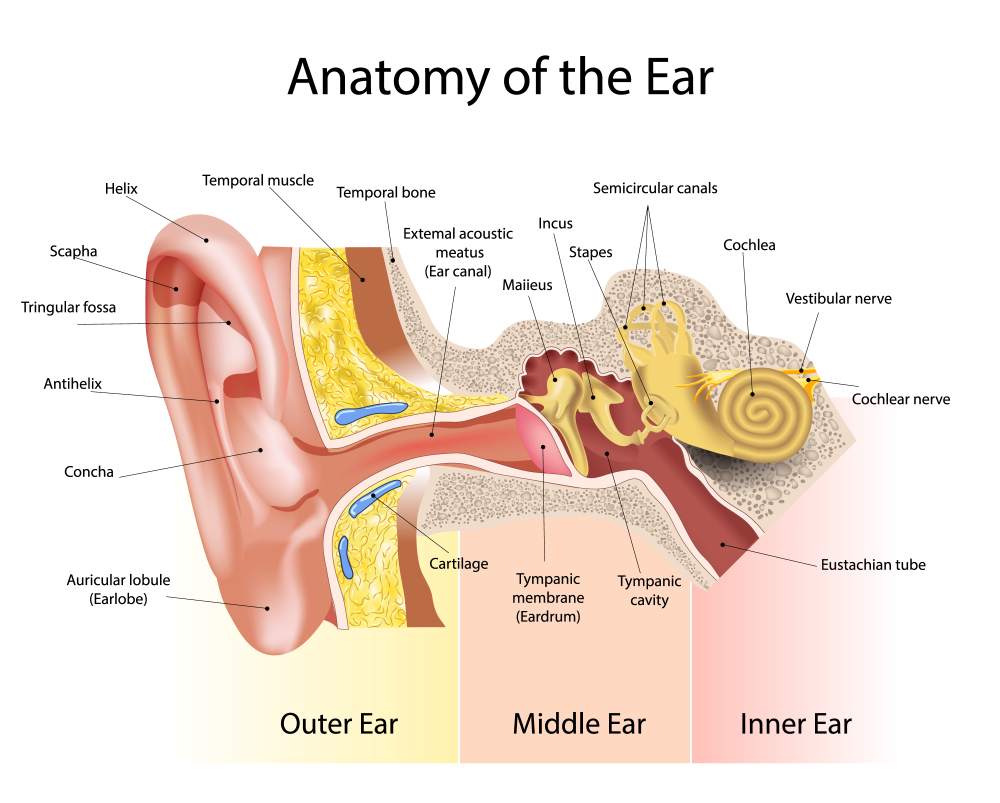What Is The Middle Ear?
The ear can be split into three parts: external, middle and inner. The middle ear’s function is to help transmit sound waves from the outer ear to the inner ear. Not only does it enable us to hear, but it also helps to maintain our balance.
Where is the middle ear?
The middle ear lies just behind the eardrum and is found in the temporal bone of the skull. It extends from the tympanic membrane to the lateral wall of the inner ear. The middle ear can be divided into two parts: tympanic cavity and epitympanic recess.
Parts of the Middle Ear
When the middle ear is viewed from an anterior view of the middle cranial fossa it consists of a bony labyrinth known as the tympanic cavity. This cavity, which adjoins the middle crania fossa, communicates with the middle ear through a narrow tube called the eustachian canal. The tympanic cavity holds the bones known as the auditory ossicles.
The epitympanic recess is a space that lies superior to the tympanic cavity. It is a small upper space in the middle ear, containing the head of the malleus bone and the body of the incus bone.
Bones of the Middle Ear
The middle ear comprises of three bones known as the auditory ossicles which transmit sound from the eardrum to the inner ear. These bones consist of:
- The hammer (malleus) – this is the largest and most lateral bone in the ear, attached to the tympanic membrane
- The anvil (incus) – this consists of a body and two limbs which attach themselves to the malleus and the incus
- The stirrup (stapes) – this is the smallest bone in the human body joining the auditory ossicles to the oval window
The Oval Window
The oval window is a membrane that covers the entrance to the cochlea in the inner ear. When sound waves vibrate the eardrum, they are transferred to the middle ear bones and travel down the hammer and anvil and then on to the stirrup which reaches the oval window.
When the sound waves reach the oval window, the middle ear functions as an acoustic transformer which amplifies the sound waves before they move to the inner ear. The pressure of the sound waves on the oval window can be 20 times higher than on the eardrum.
The Round Window
The round window allows fluid in the cochlea to move by vibrating in opposite phases to the vibrations entering the inner ear through the oval window.
The Eustachian Tube
The eustachian tube connects the ear with the rearmost part of the palate. Its function is to equalize the pressure on both sides of the eardrum so that pressure does not build up in the ear. The eustachian tube opens when you swallow, allowing pressure to equalize inside and outside of the ear.
Built-up pressure in the ear can occur in situations where the pressure on the inside of the eardrum is different from that on the outside of the eardrum. If the pressure is not equalized, it will build up on the eardrum, preventing it from vibrating properly. This can result in a slight reduction in hearing. Large differences in pressure can cause discomfort and even pain. This often happens when pressure keeps changing, such as when flying or driving in mountainous areas.
Eardrum
The middle ear is divided by a thin sheet of tissue known as the eardrum, which houses the bones of the auditory ossicles. The eardrum is very thin, only about 8-10 mm in diameter and is stretched in the middle ear by a series of small muscles. The pressure from sound waves makes the eardrum vibrate.
If you would like to learn more about the anatomy of the ear or have questions about hearing loss, schedule your free hearing test with Beltone West today.




